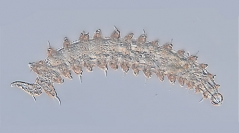

 European Journal of Taxonomy
1004 (211) - Pages 211-236
European Journal of Taxonomy
1004 (211) - Pages 211-236Two new species of Desmoscolex (Desmoscolex) Claparède, 1863 from Cassidagne Canyon (deep-sea Mediterranean), namely Desmoscolex (Desmoscolex) nibelungus sp. nov. and Desmoscolex (Desmoscolex) valkyria sp. nov. are described. Desmoscolex (D.) nibelungus has 17 main rings and the typical desmoscolecid setal pattern. The most evident features to distinguish it from the rest of D. (Desmoscolex) with these characteristics are the protuding lip region not covered with concretion material, the cephalic region that apparently lacks setae and the beak-shaped posterior-most main ring. On the other hand, D. (D.) valkyria belongs to a group of nematodes with more than 18 main rings. This new species is mainly characterized by the number of rings (22–24), the vesicular amphideal fovea, a pair of subdorsal and a pair of subventral setae both on the penultimate main ring and a long spinneret of the terminal main ring. This is the first meiofauna species described from the Cassidaigne Canyon. With the description of these two new species of nematode, the number of described species of Desmoscolex (Desmoscolex) is now 106, with 47 species occurring in deep-sea environments and 10 species described from the Mediterranean Sea.
Desmoscolecida, Nematoda, Cassidaigne Canyon, deep-sea